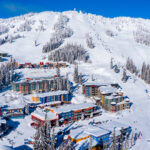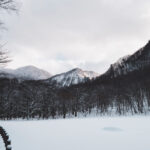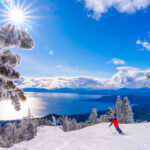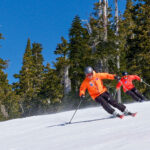From the Travel Guide 2010 issue
Where will you be skiing in February 2010? Before you answer simply Whistler, I suggest you think that through a little. Remember, the resort is called Whistler-Blackcomb (WB) for a reason. Whistler Mountain is one option for skiers, but Blackcomb Mountain is another all on its own. And while both are great, the ski experience on each is quite distinct, so the choice is an important one.
Not surprisingly, WB has had many awards and honours bestowed on it over the years. Yet despite all the recognition, there has been relatively little consideration of the question that is perhaps most relevant to skiers visiting the resort boasting two first-class mountains: Where should they ski? Which is the better half?
While it isn’t exactly as difficult a decision as that faced by Sophie Zawistowski, for many it’s emotionally charged. Skiers who frequent the resort tend to have a pretty strong opinion about which mountain is better. When I put the question to 2003 U.S. National Freeskiing Champion Jonny Law, he responded with, “People who ski Blackcomb are jerks.” While Law admits to have been “mostly joking,” according to long-time Whistler resident and Ski Canada man David Harkley, in the early days the debate regularly caused feuds between skiers and even broke apart a few lengthy ski friendships.
Whistler and Blackcomb are very different mountains with distinct histories that share custody of their skiers. Despite sitting side by side, prior to 1997 they were owned and operated independently of one another. In many ways, a skier at Whistler-Blackcomb is like a kid whose parents have separated; they are free to spend time at each fantastic home but the homes and the time spent at each are different. The opening of the Peak2Peak gondola last season effectively shortened the commute and made it easier to split time between mountains, but it has not removed the need to decide where to lay one’s tracks.
I think most would agree that Whistler has much more to offer beginners and low-end intermediates than Blackcomb. The Olympic Station is the perfect place for novices with a magic carpet, handle tow and short triple chair. The Emerald zone also offers an abundance of green runs and slow skiing areas for those who have progressed past the terrain at Olympic Station.
In contrast, some would say that higher-end intermediates might prefer Blackcomb with areas like Jersey Cream, Solar Coaster, Excelerator and 7th Heaven. I would agree, but Whistler certainly has advanced intermediate terrain as well. There is, however, an argument that Whistler’s intermediate terrain is served by fewer lifts than comparable terrain on Blackcomb and thus those lifts are more at risk of being congested.
Both mountains have an abundance of advanced terrain, but that’s also where the distinction between mountains is most pronounced and where the emotions become most intense. In my opinion, Blackcomb offers bigger terrain and longer steep skiing than Whistler, or in the words of WB athlete Mathieu Richard, “Blackcomb is more gnar.” Whistler, on the other hand, offers loads of difficult but quick steep laps off the Peak and Harmony chairs. Clearly, though, length isn’t everything to everyone. In Law’s opinion the quick laps off the Peak and Harmony allow for more accumulated vertical and more opportunity to “just go for it a little more.” According to Law, “Whistler is the place to go hucking.”
While Law concedes that Blackcomb offers quality big-mountain terrain, particularly off Spanky’s Ladder, he explains, “The airs that I’d hit in Ruby and Diamond (in competition, for example) aren’t the kind of airs I hit for fun.” On Whistler, he continues, “It is easy to get a couple hundred feet of air in a few runs. Sometimes I hit the Harmony Horseshoe air three times in a day.”
For Richard, it isn’t so much that Whistler is lacking in fun terrain, it’s more about the lack of secrecy. “Both are awesome hills,” says Richard, “but on Whistler you can pretty much see everything you would want to ski from the chairs. On Blackcomb you’ve got to know it to find your way around. So the good stuff doesn’t get skied as quickly. Whistler is rad, but Blackcomb is just a bit more gnar and secret.”
Of course, this February the Olympic events could also impact one’s choice of mountains. WB terrain is 90 per cent open throughout the Games, but there will no doubt be more crowds in town. It remains to be seen, however, whether the Olympics will have a significant impact on the crowds outside the area of the alpine venues on Whistler. Many, including Law, are of the opinion that there won’t be much impact at all. “I think it’s going to be game-on everywhere during the Olympics,” Law says. “The people in town at that time won’t be skiing.” Such an opinion seems to comply with the Utah experience in 2002. As 1997 World Extreme Skiing Champion Brant Moles recalls of his experience skiing at Snowbasin during the Olympic downhill event, “No one was skiing.”
Hopefully then, the Olympics won’t make the already complicated decision of where to ski more difficult. For those who don’t yet have a strong preference for one mountain, I would suggest this: if you are a complete beginner, a novice skier or want to catch a glimpse of the alpine venues during the Games, Whistler is the obvious choice; if you are an advanced intermediate, the choice isn’t as obvious so consider splitting your time between both mountains; if you want to go hucking in full view of the chairs and lift lines, hit Whistler; and if you prefer to get into some serious terrain away from the crowds, go explore Blackcomb. And if you have a problem with jerks on Blackcomb, go to Whistler.



